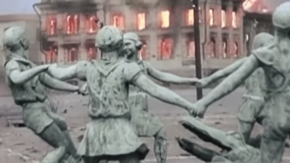Battle Of Stalingrad
 From Conservapedia
From Conservapedia | Battle of Stalingrad | ||
|---|---|---|

| ||
| Overview | ||
| Part of | Second World War | |
| Date | 23 August 1942 – 2 February 1943 | |
| Location | Stalingrad (now Volgograd, Russia) | |
| Combatants | ||
| Nazi Germany Romania Italy Hungary Croatia |
Soviet Union | |
| Commanders | ||
| Adolf Hitler Friedrich Paulus Erich von Manstein Wolfram Freiherr von Richthofen Petre Dumitrescu |
Georgy Zhukov Nikolay Voronov Aleksandr Vasilevsky Andrey Yeryomenko Nikita Khrushchev Konstantin Rokossovsky Nikolai Vatutin | |
| Strength | ||
| Casualties | ||
The Battle of Stalingrad (21 August 1942 - 2 February 1943) was a battle between Nazi Germany and the Soviet Union for the Soviet city of Stalingrad (now Volgograd). The Battle of Stalingrad was the bloodiest battle in human history, with over 1.4 million dead soldiers, and 40,000 civilian dead.[1]
The battle of Stalingrad was the turning point in World War II. It was a decisive Soviet victory, as Zhukov's Don/Stalingrad front (mainly 62nd Army) crushed von Paulus's 6th Army. Germany suffered casualties that were simply irreplaceable. Hitler's armies were no longer undefeated, their moral was severely dented and the Soviets never felt better.
The most fierce fighting occurred in the tractor factory. Had the Germans ever been able to secure Stalingrad and environs, Germany could have begun turning out tanks for its war in Russia.
The people of Stalingrad endured and fought alongside their compatriot Soviet soldiers suffering over 100,000. Stalingrad claimed over 350,000 German casualties. The Red army sacrificed 500,000 civilians to hold the city, another 500,000 soldiers were wounded or diseased.[2]
Well into the 21st century, scrap metal and human remains were still being found in the city and surrounding rural areas.
Contents
- 1 Quotes
- 2 See also
- 3 References
- 4 External links
Quotes[edit]
- "We and our allies owe and acknowledge an everlasting debt of gratitude to the armies and people of the Soviet Union."—Frank Knox, Secretary of the Navy
- "History knows no greater display of courage than that shown by the people of the Soviet Union." -- -Henry L. Stimson, US Secretary of War
- "If I do not get the oil of Maikop and Grozny then I must end this war."—Adolf Hitler
- "On the European Front the most important development of the past year has been the crushing offensive of the Great Armies of Russia..."—Franklin Delano Roosevelt
- "The disaster of Stalingrad profoundly shocked the German people and armed forces alike...Never before in Germany's history had so large a body of troops come to so dreadful an end."—General Siegfried von Westphal
See also[edit]
- List of military strategies and concepts
References[edit]
- ↑ Craig, William. Enemy at the Gates. New York: Penguin Books, 1973.
- ↑ Military History Online - Battle of Stalingrad
External links[edit]
- Stalingrad - Massengrab
Categories: [World War II Battles] [Military Strategies and Concepts]
↧ Download as ZWI file | Last modified: 02/15/2023 07:20:50 | 11 views
☰ Source: https://www.conservapedia.com/Battle_of_Stalingrad | License: CC BY-SA 3.0
 ZWI signed:
ZWI signed: KSF
KSF